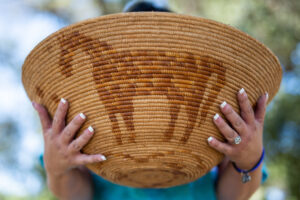Brandie | Heart Failure and Transplant Survivor
Iipay Nation of Santa Ysabel, California | Born January 1974
I didn’t want to ask for too much. I prayed that I live long enough to see my son become a man. I didn’t ask to grow old or to be an elder.
The midday sun feels particularly bright for Brandie and her son, Hunter, who are recovering from a long night and have a long day ahead. A death in their community makes for a busy weekend. As members of the Iipay Nation of Santa Ysabel, upholding cultural practices is an important duty—and hard work. The wake, which started Friday evening, didn’t stop until ten in the morning Saturday, and tonight they must attend a ritual clothes-burning for the same tribal member who passed on. The small nation, located in the mountains northeast of San Diego, is one of many Kumeyaay peoples, who are indigenous to large swaths of modern-day Southern California and Northern Baja California, Mexico.
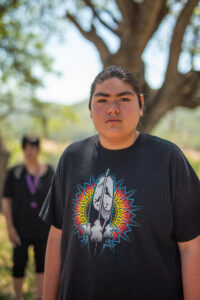
Hunter is tired but stoic, poised to carry the tasks given to him. “He’s an old soul,” says his mom. “He’s dead serious about all this stuff. He’s going to continue to do it until he’s 80 or 90 years old.” Hunter spent the night singing for the wake, chanting traditional Kumeyaay bird songs for hours on end. “I love being around our songs,” says Brandie, smiling with sincerity. “They’re thousands of years old and have been passed down orally.” Hunter has been learning songs since he could barely speak words, commencing a lifelong study. The songs function as oral history, relaying important stories, and are sung at major ceremonial gatherings. For the Kumeyaay, singing is the task for the men, while the women dance.
Wearing her ceremonial skirt, Brandie kept her feet and hips moving for as long as she could. “We have to stay on our feet dancing the whole time. You kind of get into a trance,” she says. “Not many people do it anymore—I have to take breaks.” She and other dedicated dancers support each other throughout the ceremony to persist. “For me, it’s a form of sacrifice,” she adds. Brandie’s participation in these events, no matter how physically challenging, hold deep significance for the wellbeing of herself and her people.
Sadly, for many years Brandie did not have the strength to dance as she recovered from a heart transplant in 2008. “It wasn’t until Hunter was in sixth grade, 10 years after transplant, that I really started to feel better,” she says. Being able to dance again, to support Hunter’s song, has brought an enormous sense of joy after a turbid number of years struggling with heart failure with reduced ejection fraction (HFrEF), which necessitated the heart transplant. Through strength, perseverance, and the support of Native communities, Brandie has withstood acute bouts of heart failure to accompany her son on his journey into manhood, to pass on important knowledge to her descendants.
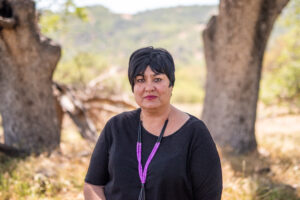
Brandie looks out over the canyonlands and mountains she calls home. The Kumeyaay once occupied much of the land from these mountains to the ocean. “My people were traditionally a fishing people,” she says. However, the oak trees that cover the rugged landscape of the mountains were also an important part of her ancestors’ diet. They would travel from coastal areas to collect and process ripe acorns. Making shawii (shoo-ee) or acorn mush was an important and time-consuming mission. It was preserved and then matted into tortillas which would serve as a main accompaniment to game or fish.
With the loss of their land, the Kumeyaay lost many traditions and access to food sources. Over several generations, this proved consequential to the tribe’s health. “I truly believe the bad health came in with the government rations,” says Brandie. “That wasn’t our diet at all and it has turned into diabetes, heart disease, lupus… We’re number one in the nation with that stuff.” The knowledge and practice of making shawii faded, and was replaced with processed foods that exacerbated public health challenges.
Like the songs and traditions of the Kumeyaay people, Brandie’s struggle with heart disease can be traced back generations on her mother’s side of the family. “My grandmother passed away from it,” she says. “All of her sisters, my great aunts, passed away from it too… It goes generations back.” A few months after Brandie’s heart transplant at age 34, her mother survived a septuple bypass surgery at the age of 55. Brandie walks a well-trodden path and while genetics clearly play a large role, no one from her family has been screened to determine the exact genetic cause.
The second of five siblings, including three younger sisters, Brandie grew up traversing the hills of the Iipay Nation. She was vivacious and full of energy to get things done—something that remains true today. She loved sports and played volleyball, softball, and basketball. “I was good at basketball,” says Brandie. “That was my ticket out.” Like many of her peers (in a high school class of only 40), she left the small, rural Iipay reservation to attend Palomar College, near San Diego, where she played hoops and then transferred to Arapaho University in Colorado. Like the majority of the Iipay tribal members, she chose to live outside the reservation post-graduation. Brandie spent many years in San Diego, but held a strong desire to remain engaged with the tribe, commuting to the Nation for important meetings and events.
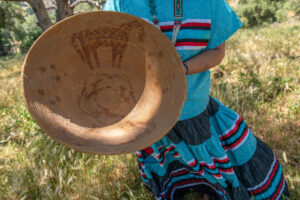
“I first got involved in tribal politics when I was 28,” says Brandie. She ran against a long-time incumbent Vice Chairwoman, and to her own surprise, won. “Then, I just continued to win every election,” she says. For the next 17 years, despite numerous hospitalizations due to her condition, Brandie continued to serve her community as an elected leader. In 2020, Brandie was elected Chairwoman for the tribe, just in time to handle the myriad of challenges wrought by the COVID pandemic. In 2021, she stepped down from her position. Even before the pandemic, Brandie’s job was difficult. Tribal politics are complex and require patience. She managed numerous projects on the reservation concerning all areas of life while also navigating generations-old disputes between families. “Imagine you’re a mayor at meetings with all your cousins! That’s how it is.”
For Brandie, returning to the reservation became paramount in 2005 when she learned she was pregnant. “I came back because I couldn’t imagine raising my son in the big city of San Diego.” She wanted to instill the values and experiences that she had growing up on the reservation. Her intuition spoke loudly. “I knew I was having a boy,” says Brandie. “I knew the responsibility that came with that. Our boys are the only ones who can sing. He was going to have to carry on that tradition.”
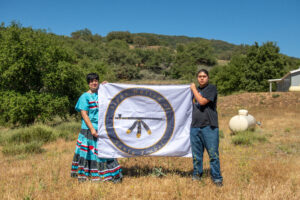
While pregnant, Brandie continued a busy life, attending tribal meetings, but felt noticeably off. “I was really tired. I couldn’t sleep. I had shortness of breath. I would cough all the time. My feet were swollen.” At eight months, things reached a breaking point and she visited Indian Health Services (IHS).
“They told me, ‘You’re eight months pregnant,’ and gave me an inhaler,” Brandie recalls. While all tribal members living within the borders of the United States are granted free healthcare through IHS, the system is notoriously understaffed. “They don’t have specialists,” says Brandie. “They didn’t have a cardiologist I could visit. They didn’t even have an OB/GYN. I saw a different person every time I went.” Lacking real continuity of care, Brandie’s concerns were not taken seriously.
A few days later Brandie and her mother drove to a larger hospital in Escondido. Brandie needed to be pushed in a wheelchair, but again, she was told to go home. “At this point I thought I was going crazy,” says Brandie. “Everyone is telling me that I’m fine.” As a new mother, Brandie fought against assumptions of her own weak willpower or incompetence. Determined to get the care she deserved, she and her mother drove to Sharp Memorial Hospital in San Diego.
At Sharp, the tone was noticeably different. “I was told I was having complete heart failure,” remembers Brandie. She was transferred into the intensive care unit (ICU) where she and her unborn baby remained under strict observation. Her siblings and mother took turns with her in the room over the next two days until things again took a turn. “I heard them announce a code-blue over the intercom,” says Brandie, “I thought, ‘I need to pray for whoever that is.’” To her surprise a team of nurses rushed into her room—she was coding. There was little time to explain what was happening. As Brandie sped out of the room, surrounded by physicians, her sister reached out and touched her toe—a last moment of physical contact with family before going into the operating room.
Brandie’s heart was almost entirely unable to pump the necessary amount of blood to keep her and her baby alive. Her ejection fraction (EF), or the amount of blood being pumped out of her left ventricle, stood at only 10%. Any EF lower than 40% is considered dangerous. Brandie’s heart was failing, and now Hunter’s was starting to as well. Doctors knew that the only way to save them both was to perform an emergency C-section.
The bright lights of the operating room beamed into Brandie’s eyes—she lay wide awake as doctors performed the operation as quickly as possible. At the sound of Hunter’s first cry, tears of joy and relief streamed down Brandie’s face, but she could not see him yet. Instead, Doctors rushed newborn Hunter off to intensive care. It wouldn’t be until a few days later, in the neonatal ICU, that Brandie first met her son.
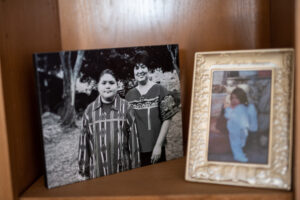
Hunter returned home two weeks before Brandie, and even then, their rendezvous was brief. Hunter remained at his grandmother’s house as Brandie went back and forth from the hospital. “The first two years of his life I was constantly in the hospital,” recalls Brandie. “Today Hunter still gets stressed when I have to go.”
Six months later, in March 2006, doctors attempted to place an implantable cardioverter defibrillator (ICD) in Brandie’s chest, but the surgery didn’t go as planned. “They had to do it three times,” says Brandie. The pacemaker wasn’t working properly, although the defibrillator proved functional. “It has shocked me twice.” Her heart limped along, as her condition continued to deteriorate.
“In April 2008, I was listed for a transplant,” says Brandie. “They gave me a pager. I didn’t know if it would even work on the reservation.” It was unclear how or when a match would arrive—Brandie spirits were low. “I was willing to do anything. I felt like a candle with my flame going out. The doctors didn’t know what to do. I’ve heard nightmare stories of people waiting for years and years, and needing to get an LVAD [left-ventricular assistance device].”
News of Brandie’s troubles had spread from her immediate family to the larger tribe and to neighboring nations. A man from the Cocopah Nation in Arizona, showed up at the hospital one day and offered to organize a healing ceremony with a well-known Lakota medicine man from Pine Ridge Reservation. Her doctors showed no resistance, and sent her back to the reservation with an IV in order to receive the medicine for the ceremony. With preparations underway, Brandie invited her closest friends and family to participate.
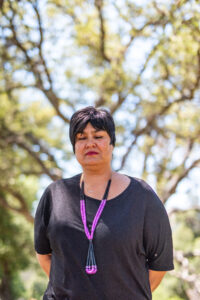
The Yuwipi (yoo-WEE-pee) ceremony, originally belonging to the Lakota peoples, involves a long sweat followed by a ceremonial song. It is a borrowed tradition for the Kumeyaay as their medicine men and their practices have long since vanished. While Brandie had attended Yuwipi ceremonies before, having one done for her was transformative. “The medicine man sings and you call in your ancestors and he talks to them. I could feel the people around.” With their presence near, Brandie asked for death to spare her, for a time. “I didn’t want to ask for too much. I prayed that I live long enough to see my son become a man. I didn’t ask to grow old or to be an elder.”
Brandie returned from the ceremony to the hospital where her health took a turn for the worse. “I began making my funeral arrangements,” she says. Anticipating her time was coming soon, she began writing stories to Hunter, sharing recollections and reflections from her life and from her parents and ancestors until she became too weak to hold a pen.
On a Thursday night doctors entered her room. There was surprising news. They had found a donor. A suitable match. The very next day, Friday the 13th of June, 2008, Brandie returned to the operating room with a team of surgeons to replace her heart. The anesthesia mask was strapped over her mouth and nose, and all went dark.
When Brandie awoke, she was in a hospital room surrounded by her family. Her sisters shouted exuberantly, “It was a perfect match!” But Brandie was in too much pain to join in their jubilation. “I guess my heart was so enlarged—so damaged—that they had to open my sternum up to remove it, and then wire it back together.” Nonetheless, her life and her dream of raising Hunter were both still intact. “I truly believe that ceremony saved me,” she reflects. “It kept me just long enough to get my transplant.”
Now, after years of recovery, Brandie’s life remains busy, although a sense of another decline is never far. “Cancer is almost inevitable with all the medications I take post-transplant,” she says. Like all transplant recipients, her heart comes with an unknown expiration date, something that worries Brandie less. “The average lifespan is 20, maybe 25 years… In a few years Hunter will be 18. Then, he can start life as an adult. I just want to be around long enough for that… maybe to see him get married.” She says she isn’t planning on seeking a second transplant.
In the meantime, Brandie does her best to utilize the time she has left. Not long after Hunter was born, she started working with WomenHeart, a national nonprofit dedicated to serving the needs of women with heart disease. “I’ve been lucky enough to speak at many different places,” she says. Her advocacy work focuses on telling the realities for women and specifically Native women living with heart disease. Her voice has been heard from distant reservation lands to the halls of the White House during the Obama Administration. “We need more funding for more research, more studies, and better healthcare for women in general.”
Alongside medical advancements, Brandie sees preserving her cultural traditions as vital to the health of her people. This is the knowledge she hopes to pass on through Hunter’s generation—the importance of ceremony, of traditional practices, of foods. In recent years, local efforts to revive the harvesting of acorns and making shawii are good indications that Hunter’s generation will fare better. “The current generation is amazing,” she says. “They are so committed to reviving a lot of our traditions, and carrying them on.” Tiredness is quickly catching up to the two. Brandie rests her head on Hunter’s broad shoulders. “Being an Indian is hard work,” she says. They say goodbye and duck into their home to take a nap—to save their energy for the coming ceremony tonight.
